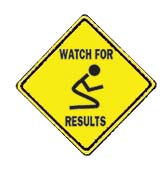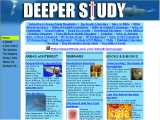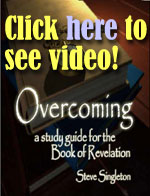  Welcome to issue #10! I hope you will profit from it. I tend to assume that if I am learning from the research I'm doing, that others probably will learn something too. I surely hope that is true. Please continue to send me your feedback about what you like or don't like, and what makes you agree or disagree with what I'm saying. Starting next time, I will begin to include some of the feedback in each issue. Please let me know if you don't want the content of your e-mail to be shared in an upcoming newsletter. This newsletter reaches Christians and seekers on five continents. Pray that it will encourage, correct, and instruct.
I have a long-term goal--a life-long goal really--to develop the mind of Christ (1 Cor. 2:16). I want to think His thoughts, to share His attitudes, and to see the world and its people as He saw them, as He sees them. Jesus found spiritual truths in every-day incidents, like straining milk into a pitcher or setting aside a lump of dough to rise. I want to find such insights in the world racing past me, but I must confess that it doesn't often happen. I think this is because I do not yet see things often enough from a spiritual point of view. One day recently, though, I was downtown, walking beside the train tracks, when something on the other side caught my attention--a person hurrying along who had a familiar face. I stopped for a moment to watch, and as I did, a commuter train whizzed by. For a second I was annoyed that the train was blocking my view, but then I realized that I could still see the walker if I looked through the windows on both sides of the train and ignored the solid walls as they shot past. Almost immediately I was struck with the lesson acted out before me. We sometimes try to examine eternal truths, like love, justice, mercy, or humility, and just as we begin to identify the ways we connect to them, the commuter-train-busyness of life careens past, distracting us and blocking our view. Only by concentrating and focusing on what is important can we regain our vision of the eternal. And then sometimes, our attention can be so set that we hardly even notice what whizzes and clackety-clacks just past our noses. Paul put it this way, "We fix our eyes, not on what is seen, but on what is unseen. For what is seen is temporary, but what is unseen is eternal" (2 Cor. 4:18). Where is your focus today?
Paul and Peter made remarkably similar pleas regarding how Christian women should and should not make themselves beautiful. They urged: I also want women to dress modestly, with decency and propriety, not with braided hair or gold or pearls or expensive clothes, but with good deeds, appropriate for women who profess to worship God. --1 Tim. 2:9-10 Your beauty should not come from outward adornment, such as braided hair and the wearing of gold jewelry and fine clothes. Instead, it should be that of your inner self, the unfading beauty of a gentle and quiet spirit, which is of great worth in God's sight. --1 Peter 3:3-4 We of the 21st century can't help wondering, why the emphasis on avoiding braided hair? Does this apply to Christian women today? Is it an absolute prohibition, and if so, why single out this hairstyle? Could not Paul and Peter have said the same things about hair that is waved or curled or frizzed? What do these passages say to us today? We know from the art and literature of the first two centuries of the common era that women were as conscious of their appearance--particularly their hair--then as now. For example, Ovid (43 B.C.E. - 17 or 18 C.E.) describes the situation in the early first century (Ars Amatoria 3.137-140). Watch for various styles (and unstyles) and for references to hair dyeing and wigs. There isn't only one style: choose what suits each one, and consult your mirror in advance. An oval-shaped But you'll no more number the acorns on oak branches, or bees on Hybla, wild beasts on Alpine mountains, than I can possibly count so many fashions: every new day adds another new style.
And tangled hair suits many girls: often you'd think it's been hanging loose since yesterday: it's just combed. Art imitates chance.... O how kind nature is to your beauty, how many ways you have to repair the damage!
We [men] are sadly exposed, and our hair, snatched at by time, falls like the leaves stripped by the north wind. A woman dyes the grey with German herbs, and seeks a better color by their art: a woman shows herself in dense bought curls, instead of her own, pays cash for another's. Throughout the
first two centuries hairstyles went through cycles, A survey of hairstyle changes 1. Simple (Augustus through Caligula, 27 BCE–41 CE) – At the beginning of the era we are
considering, women's hairstyles tended to be uncomplicated. Even Cleopatra, famous for her alluring charms, is
portrayed with a rather
simple style that includes what appear similar to "corn rows" on the sides of her head and a coil of braids bound at the back. One of
her contemporaries in Rome was Agrippina the Older,
depicted beginning of the era we are
considering, women's hairstyles tended to be uncomplicated. Even Cleopatra, famous for her alluring charms, is
portrayed with a rather
simple style that includes what appear similar to "corn rows" on the sides of her head and a coil of braids bound at the back. One of
her contemporaries in Rome was Agrippina the Older,
depicted  with a center part, her hair gathered and tied high at the back of her head. with a center part, her hair gathered and tied high at the back of her head.
The most famous and perhaps most influential woman of the next generation was Livia,
the wife of Caesar Augustus. One sculpture portrays her with a flip above the forehead, the sides in waves, and a small coil of braids at the back of her
neck. No doubt the simplicity of her It is possible--indeed
likely--that as the first century progressed, these simpler hairstyles continued
among the common people, even while the hair at court became more and more
elaborately dressed. For example, the volcanic ash that destroyed Pompeii in 79 CE preserved
numerous Throughout the entire period we are considering, well-to-do women had slaves who specialized in hair-dressing. Those of the lower classes went to beauty shops similar to those of today. One sculpture depicts not one attending slave, but four (one doing the work, one holding the mirror, and two supervising--how little has changed in 2000 years!).
"Why is this curl standing up" she asks, and then down comes a thong of bull's hide to inflict chastisement for the offending ringlet. Pray, how was Psecas at fault? How would the girl be to blame if you happened not to like the shape of your own nose? Another maid on the left side combs out the hair and rolls it into a coil; a maid of her mother's, who has served her time at sewing, and has been promoted to the wool department, assists at the council. She is the first to give her opinion; after her, her inferiors in age or skill will give theirs, as though some question of life or honor were at stake. The poet Martial (40-104 CE) describes a similar scene (Epigrams, 2.66):
 she had seen it, and Plecusa, struck down by the savage tresses, fell. Now stop, Lalage, arranging your grim hair, and let no girl touch your demented head. Let a salamander leave its mark, or let a cruel razor denude it, so that your reflection might become worthy of your mirror. she had seen it, and Plecusa, struck down by the savage tresses, fell. Now stop, Lalage, arranging your grim hair, and let no girl touch your demented head. Let a salamander leave its mark, or let a cruel razor denude it, so that your reflection might become worthy of your mirror.
Apparently the ancients believed that a salamander's excretions would make hair fall out. 2. Transition (Claudius through Nero, 41–69 CE) – perhaps Messalina was incurably immoral (see Juvenal, Satire 6, 114-132), nightly forsaking the imperial palace for Rome's brothels where she played the harlot to every man willing to pay her fee. Since prostitutes of that day stood out because of their blonde hair, Messalina nearly always wore a blonde wig on these adventures. Apparently, her example made both blonde hair and wearing wigs popular among the high society women of the day, for after her death both were extremely popular, and not just among the "women of the night." Messalina's unwigged hairstyles also became more elaborate than those of women before her, according to her sculpted portraits that Her successor as wife of the emperor Claudius, Agrippina the Younger, also has an elaborate coiffure, compared to the women who strolled the imperial palaces before her. Her hairdo consists entirely of tight curls, except that the back is still tied in the more traditional way. Agrippina murdered her husband Claudius and, in turn, suffered murder by order of her Some time during the final years of Nero is the most likely date for the writing of First Timothy and First Peter, assuming that the apostles are the real authors of the epistles. The styles we have discussed until now form the background for their commands; the following styles are the foreground. 3. Ornate (Vespasian through Hadrian, 69–138 CE) Nero's ultimate successor was Vespasian. He and his two sons, Titus and Domitian, Hairstyles of this Flavian period seem to fit well 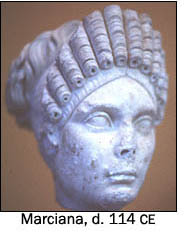 So numerous are the tiers and storeys piled one upon another on her head! In front, you would take her for an Andromache; she is not so tall behind: you would not think it was the same person. So numerous are the tiers and storeys piled one upon another on her head! In front, you would take her for an Andromache; she is not so tall behind: you would not think it was the same person.During the reigns of Nerva, Trajan, and Hadrian, the orbis was made by wrapping hair around metal strips, sometimes partially exposing the metal. Also tortoise shells and other items were embedded in the hair just above the forehead to maintain a similar high front to the "do," but without the masses of hair worn under the Flavians. Marciana, for example, the older sister of Trajan and grandmother of Hadrian's wife At about the same time belongs an unidentified bust that demonstrates the excesses to which women of Trajan's era resorted. Her hairstyle has the same vertically cylindrical curls as Marciana's, but with a Raponzel-length coil of hair, doubtless not her own, braided and coiled into a massively decadent display. Trajan's wife, Plotina, appears in a bust with Marciana's daughter Matidia appears with a number of styles, including one with on orbis consisting of rows of vertical, cylindrical curls and the wrapped strips Hadrian's wife Sabina still has the wrapped metal strip framing the face, but her "do" is considerably simpler than her mother's or grandmother's. Her coil of braids is unusual because it is also twisted and seems to be supported by some kind of band (of metal?). 4. Back toward Simple (Antoninus Pius through Constantine, 138–337 CE)
Faustina the Older, wife of Antoninus Pius, parts her waved hair at the forehead and coils her braid straight up on top. She also has other, much more elaborate
styles (see the first link under "Want to go deeper?" below). According to Corson (75),
Faustina the Older is
An exercise in Bible interpretation Two questions present themselves immediately when we attempt to analyze First Timothy 2:9 and First Peter 3:3 with a view to making modern applications. 1) How literally should we take these verses? We should at least allow for the possibility that Paul and Peter are both using a figure of speech. When they say, "Not x, but y," perhaps they mean "y more than x." This would not be a complete prohibition of braided hair, gold, pearls, and expensive clothes, but an emphasis on the internals over the externals. A clear example of this figure of speech is John 6:27: "Do not work for food that spoils, but for food that endures to eternal life, which the Son of Man will give you.” Is this verse prohibiting working so that we can eat? No, it is putting the emphasis where it belongs, on spiritual sustenance. Consider also Matt. 12:7, which is quoting Hosea 6:6: "I desire mercy, not sacrifice." This is certainly not a prohibition of animal sacrifices, for the Mosaic covenant, under which both Hosea and Jesus lived, made them a requirement of every believer. Instead, the statement lays stress on the attitude of the heart over the value of the external offering. The one justly claims priority over the other. We could make a similar case for the oft-quoted "Judge not...." As Bible scholar Robert Stein points out (51): [T]he apparently absolute and unconditional "Judge not, that you be not judged" (Matt. 7:1), is followed in the next verse by the warning that God will judge us by the same standard by which we judge others (and for Matthew, God's judgment of the world is inevitable). There follow the warning against seeing a speck in our brother's eye and not seeing the log in our own (vv. 3-5), and the command not to giver to dogs what is hold or to throw our pearls before swine (v. 6). This command of course entails making a judgment regarding to whom we are not to give what is holy. Matthew clearly did not see any conflict between the prohibition of judging in verse 1 and the judging described and commanded in the following verses.... Obviously the prohibition in Matthew 7:1 does not exclude the church discipline prescribed in Matthew 18:15-17. This is possible only if Matthew 7:1 is understood as an example of overstatement. Jesus uses a similar figure of speech when he says, “If anyone comes to me and does not hate his father and mother, his wife and children, his brothers and sisters–-yes, even his own life-–he cannot be my disciple" (Luke 14:26). Jesus is emphasizing that loyalty to Him must take priority over all of the loyalties one's duty naturally assumes. (Compare Mal. 1:2-3). If a similar figure of speech operates in First Timothy and First Peter, then the two apostles would be stating in a forceful way that the adornment of the inner person claims a higher priority than outward adornment. Whether we allow that such a figure of speech occurs in these passages, we can agree that the two apostles are urging us to go at least this far: Christian women (and men, for that matter) should focus on enhancing their inner beauty more than their outer. 2) What in these verses is culture-bound and what transcends culture? The extensive survey of first-century women's hairstyles we have just undertaken suggests that Paul and Peter were addressing a phenomenon of the place and time in which they lived. Braided hair was "the thing" in the first century, just like wavy hair became the rage in the second and third. The culturally specific element of these verses is the way that women of
their time adorned themselves. The underlying principle that transcends culture
is the emphasis on internal adornment over external. That underlying principle
might have different specific manifestations in a culture separated from the
first-century Roman Empire. What we need to do is summarized well by theologian Millard J. Erickson (75): [W]e need to be certain that we clearly distance ourselves from the biblical situation before we attempt to apply it to our situation. This distancing will ensure that we do not too easily make a translation from the biblical situation to our own. We will need to engage in as careful and thorough an exegesis of the contemporary situation as we do of the biblical context. Only then will we be able to find an appropriate parallel in the present to the text we are trying to apply to it. Of course, a degree of subjectivity is involved in this process, as it is in all attempts at biblical interpretation. Opinions may differ, for example, in identifying the underlying timeless, transcultural principle involved in a particular passage. In a similar way, diversity of opinion may arise in recognizing the modern cultural manifestation of that underlying principle. But at least, with the diagrammed process clearly before us, we can be aware of the danger zones where we can so easily go astray. When differences arise, we can explain the basis on which we made our choice and why we rejected alternatives. The main point These two verses challenge us to ask ourselves, what are our values concerning beauty? Our culture is very conscious of physical beauty, and whole industries have arisen that cater to the almost universal desire to make ourselves more attractive than we would be otherwise. Even if we were to examine modern braids, we do not have to search long to find styles as elaborate or even more elaborate than those of the first few centuries. The woman second from the left below is not wearing a hat--that is her hair braided in a style known as "basket-weaving"!
Not only could we point to hair stylists and wig manufacturers, but also to the entire cosmetics, perfume, and plastic surgery industries. This high premium that our culture places on physical beauty has permeated the Christian subculture. We would be hard pressed to distinguish Christians from their non-Christian counterparts by measures of the time, money, and attention they give to their appearance. The ultimate question about all of this is, what is important from God's perspective? What does He value, and therefore what do people value who desire to think His thoughts after Him? What kind of beauty does not fade, but only increases as time passes? That's the kind of beauty God wants us to have. It's the beauty that Father, Son, and Spirit share. This inner beauty is the heritage, the destiny, for every woman, or man, that submits to the transforming will of God in their lives. Next issue Early Christian writers of the first few centuries after the death of the apostles (commonly called the "Church Fathers") have a great deal to say about women's hair and physical beauty. In issue 11 I will describe how they deal with this issue. Some of their arguments are profound; others are erroneous and, frankly, foolish. Hopefully, the discussion will provide all of us with more to consider on this important topic. Want to go deeper?
Many have benefited from this booklet in English, and it has been translated into Hungarian for use on the mission field. Plans are underway to translate it into Spanish for use in South America. It is a free e-booklet, but if you want hard copies, they are available at 12 for $9.95. Order your dozen today for your own study and to share with your friends and relatives!
Of course, there's no charge for the newsletter (there never is). Just make sure that the e-mail addresses are valid ones and send them on to me. Even better, let you friends know that you are signing them up. Claim your Prayer Roadsigns today! Free offers from earlier issues (for 5 new subscribers each):
| |
| DeeperStudy.com provides a growing array of Bible study resources for new and mature Christians, as well as seekers. For example, in March 2005 we added links to online Bible commentaries, and more will be added as we find them. Deeperstudy.com will give you much of what you need to go as deep as you want in your study of God's Word.
Great buy!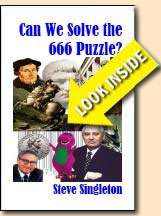 You've heard opinions and theories about the meaning of 666, some from respected Christian friends, and some from the tabloids. I wrote this full-length e-book to help you sort the far-fetched speculations from the real possibilities. Now you can own this thoroughly researched, thoroughly documented study of the meaning of 666 for only $9.95. And because it's an e-book, there's no shipping cost! Read this review by John Clayton. Get you copy today! |
Sale! $5 off on Overcoming!
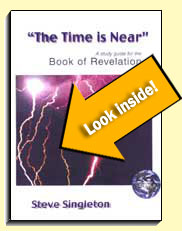 The Time is Near still availableWe still have a few copies of the second edition, called The Time is Near! It is 279 pages and is the same as the 3rd edition, including the 65-page introduction, over 100 charts, the special 50-page section on the hermeneutics of the "Left Behind" series, and a scripture index to spiritual songs based on Revelation, but without the additional material on chapters 2 and 3. This is a bargain at only $24.95 plus shipping! This offer is good only while our supplies last, so hurry! |
|
Now you can get BEHIND "LEFT
BEHIND"! The popular novels by Tim LaHaye and Jerry B. Jenkins assume 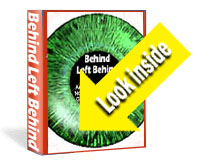 the truth of an understanding of end-time events known as
Dispensational Premillennialism. It's certainly popular, but is it right?
This full-length e-book (50 8-1/2"x11" pages) examines LaHaye and Jenkins'
treatment of the end-time prophecies in the light of Bible interpretation
errors to which all Bible students are prone. At just $9.95, you don't want to pass up
this in-depth study. the truth of an understanding of end-time events known as
Dispensational Premillennialism. It's certainly popular, but is it right?
This full-length e-book (50 8-1/2"x11" pages) examines LaHaye and Jenkins'
treatment of the end-time prophecies in the light of Bible interpretation
errors to which all Bible students are prone. At just $9.95, you don't want to pass up
this in-depth study. | |
Copyright ©2005
Steve Singleton, All rights
reserved. [Our
privacy policy] rights
reserved. [Our
privacy policy]
If you believe you are receiving DeeperStudy Newsletter in error or desire to be taken off our mailing list, you may unsubscribe here. Your name will be removed promptly. | |




 head suggests a plain parting.... A round face asks for a small knot on the top, leaving the forehead free, showing the ears. One girl should throw her hair over both shoulders.... Another tied up behind.... Blown tresses suit this girl, loosely scattered: that one's encircled by tight-bound hair. This one delights in being adorned by tortoiseshell from Cyllene: that one presents a likeness to the curves of a wave.
head suggests a plain parting.... A round face asks for a small knot on the top, leaving the forehead free, showing the ears. One girl should throw her hair over both shoulders.... Another tied up behind.... Blown tresses suit this girl, loosely scattered: that one's encircled by tight-bound hair. This one delights in being adorned by tortoiseshell from Cyllene: that one presents a likeness to the curves of a wave.
 much as they do in modern
times. Generally during this period, we can discern four stages in the history
of hair styles: simple, transition, ornate, and back toward simple. Yet the
common element of all four stages was—braided hair.
much as they do in modern
times. Generally during this period, we can discern four stages in the history
of hair styles: simple, transition, ornate, and back toward simple. Yet the
common element of all four stages was—braided hair.  hairstyle was imitated by women around the
Empire. Another
woman of the same
era was Antonia Augusta, who wore a similar style
of center part, wavy hair on the sides, reaching back to a short braid doubled back, with the
end tucked and pinned at the nape of the neck. Octavia,
the emperor's sister, had a coiffure similar to Livia's.
hairstyle was imitated by women around the
Empire. Another
woman of the same
era was Antonia Augusta, who wore a similar style
of center part, wavy hair on the sides, reaching back to a short braid doubled back, with the
end tucked and pinned at the nape of the neck. Octavia,
the emperor's sister, had a coiffure similar to Livia's.
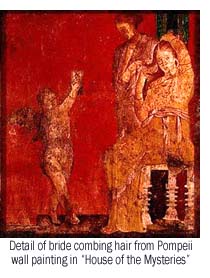 wall paintings. One depicts a woman with her writing pen and small book. She wears a simple hairstyle, held in place by a golden hairnet. One such net, consisting of a
loose weave of thin, gold wires, has survived to
wall paintings. One depicts a woman with her writing pen and small book. She wears a simple hairstyle, held in place by a golden hairnet. One such net, consisting of a
loose weave of thin, gold wires, has survived to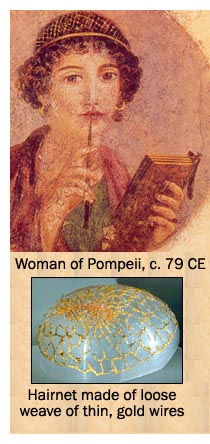 the present. In another
painting, a bride combs her hair while a cupid holds a mirror for her. Her
hair is parted down the middle and seems to be without wave or curl (at least for the moment). The strands are separated at the back, probably because they
are about to be braided.
the present. In another
painting, a bride combs her hair while a cupid holds a mirror for her. Her
hair is parted down the middle and seems to be without wave or curl (at least for the moment). The strands are separated at the back, probably because they
are about to be braided.
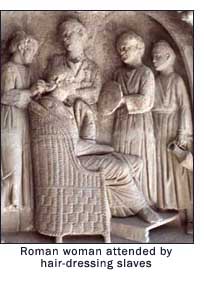 Two first-century writers report how such slaves were treated. The satirist Juvenal (55-127 CE) describes one rich matron (Satire 6, part 2):
Two first-century writers report how such slaves were treated. The satirist Juvenal (55-127 CE) describes one rich matron (Satire 6, part 2):
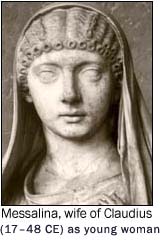 with the rise of Valeria Messalina, wife of the Emperor Claudius, that women's hairstyles began to make the transition toward the elaborate excesses of the Flavian period.
with the rise of Valeria Messalina, wife of the Emperor Claudius, that women's hairstyles began to make the transition toward the elaborate excesses of the Flavian period.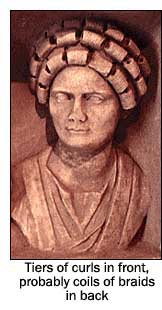
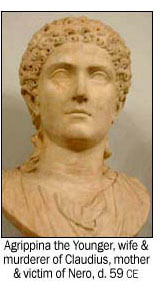 have survived. In a bust of her as a young woman, she has wavy
have survived. In a bust of her as a young woman, she has wavy  hair on the sides in a style similar to her predecessors, but with pin curls framing her face. In a more mature portrayal, she has rows of large, cylindrical curls across the top of her head. This kind of style became more and more popular from her time forward for the next 40 years.
hair on the sides in a style similar to her predecessors, but with pin curls framing her face. In a more mature portrayal, she has rows of large, cylindrical curls across the top of her head. This kind of style became more and more popular from her time forward for the next 40 years.
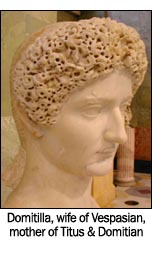 son, the emperor Nero. Nero's wife, Poppea,
son, the emperor Nero. Nero's wife, Poppea,  whom he also murdered, wore a "do" essentially like Messalina's (face framed with pin curls with large, cylindrical curls across the top and hair tied at the back), but she added a large crown integrated into the style. This innovation would skip a generation and return at the dawn of the second century.
whom he also murdered, wore a "do" essentially like Messalina's (face framed with pin curls with large, cylindrical curls across the top and hair tied at the back), but she added a large crown integrated into the style. This innovation would skip a generation and return at the dawn of the second century.
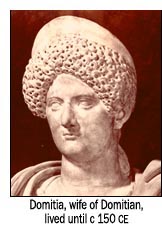 called "the Flavians" after their family name, had a combined reign from 69 to 96 CE. During the Flavian period, women's hairdos evolved into styles that today seem pompous, even grotesque.
called "the Flavians" after their family name, had a combined reign from 69 to 96 CE. During the Flavian period, women's hairdos evolved into styles that today seem pompous, even grotesque. 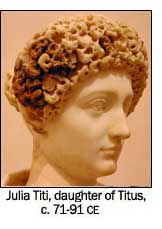 Characteristic of this period was a heavy arch of hair above the forehead called an orbis, consisting sometimes of tight curls, sometimes of frizz, but in both cases supported by a crescent frame of wires.
The hair at the back of the head was braided, and the
braids were either drawn together and tied, or more often twisted into a coil open in the center and pinned tightly to the head.
Characteristic of this period was a heavy arch of hair above the forehead called an orbis, consisting sometimes of tight curls, sometimes of frizz, but in both cases supported by a crescent frame of wires.
The hair at the back of the head was braided, and the
braids were either drawn together and tied, or more often twisted into a coil open in the center and pinned tightly to the head. 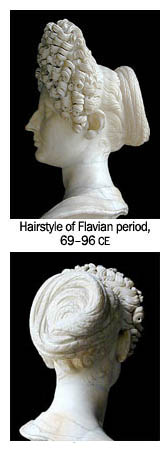 the description of Juvenal (Satire 6.501-504):
the description of Juvenal (Satire 6.501-504):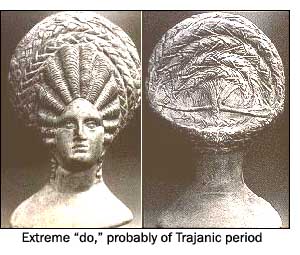 Sabina, framed her face with tightly wrapped strips of metal, above which were vertical row of large, cylindrical curls. Her hair in back was braided and coiled.
Sabina, framed her face with tightly wrapped strips of metal, above which were vertical row of large, cylindrical curls. Her hair in back was braided and coiled.
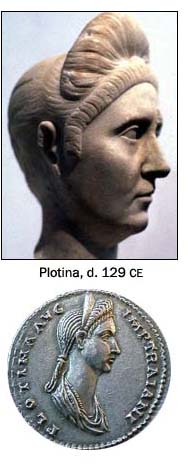 similar strips wrapped with hair, a fan-like pompadour, and the hair behind very close to the head. A coin depicts her with an orbis in front and "corn row" braids along the top and sides, gathered at the back.
similar strips wrapped with hair, a fan-like pompadour, and the hair behind very close to the head. A coin depicts her with an orbis in front and "corn row" braids along the top and sides, gathered at the back.
 framing the face. In a second, the strips are still there, but now the orbis has two rows of large pin curls. In a third style, the hair is braided (almost woven) over supporting arcs of wire or metal strips. The hair behind is a coil of braid worn high on the head and open in the middle. Two unidentified women of the same era have styles that seem to be variations of Plotina and Matidia's. The portrait of an unidentified Roman matron
atop her sarcophagus has a style similar to
framing the face. In a second, the strips are still there, but now the orbis has two rows of large pin curls. In a third style, the hair is braided (almost woven) over supporting arcs of wire or metal strips. The hair behind is a coil of braid worn high on the head and open in the middle. Two unidentified women of the same era have styles that seem to be variations of Plotina and Matidia's. The portrait of an unidentified Roman matron
atop her sarcophagus has a style similar to 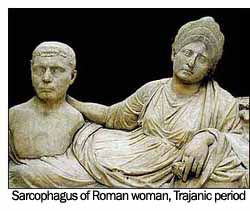 Marciana and one of
Marciana and one of 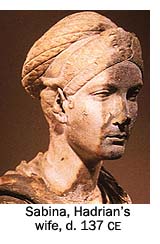 Matidia.
Matidia.
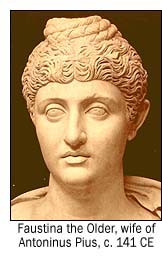
 Compared with the hairstyles of the late first and early second centuries, those of the rest of the second and all of the third were relatively simple, certainly less ostentatious, though there were notable exceptions. During this period, the braid continued as a an important element in most of the styles.
Compared with the hairstyles of the late first and early second centuries, those of the rest of the second and all of the third were relatively simple, certainly less ostentatious, though there were notable exceptions. During this period, the braid continued as a an important element in most of the styles.
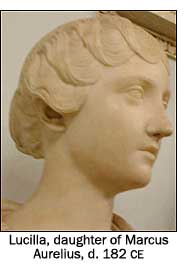 supposed to have worn 300 wigs in 19 years.
supposed to have worn 300 wigs in 19 years.
 Faustina the Younger, wife of Marcus Aurelius, continues the center part and increases the waves.
Their daughter, Lucilla, has a style that seems a throw-back to the times of Agrippina the Older and Antonia Augusta, more than 100 years earlier. It also has a center part, waves, and a modest coil of braids above the neck. Waves seem to be a popular new element.
Faustina the Younger, wife of Marcus Aurelius, continues the center part and increases the waves.
Their daughter, Lucilla, has a style that seems a throw-back to the times of Agrippina the Older and Antonia Augusta, more than 100 years earlier. It also has a center part, waves, and a modest coil of braids above the neck. Waves seem to be a popular new element.
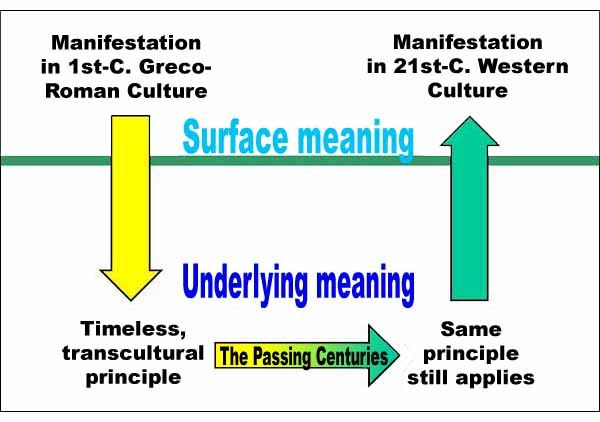


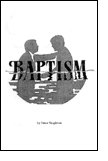 If you've ever wondered what the Bible really teaches about the role of baptism in salvation, here is the study for you: "Baptism: A Study-It-Yourself Guide." After a brief introduction, this booklet features a Bible passage with illustration on each left opening with an explanation and multiple-choice questions on the right. The booklet concludes with a summarizing illustration and series of questions.
If you've ever wondered what the Bible really teaches about the role of baptism in salvation, here is the study for you: "Baptism: A Study-It-Yourself Guide." After a brief introduction, this booklet features a Bible passage with illustration on each left opening with an explanation and multiple-choice questions on the right. The booklet concludes with a summarizing illustration and series of questions.

